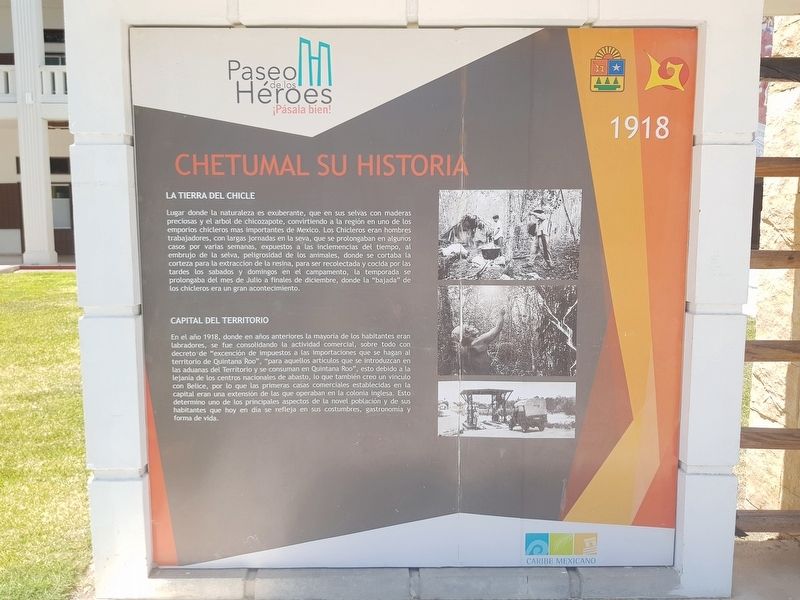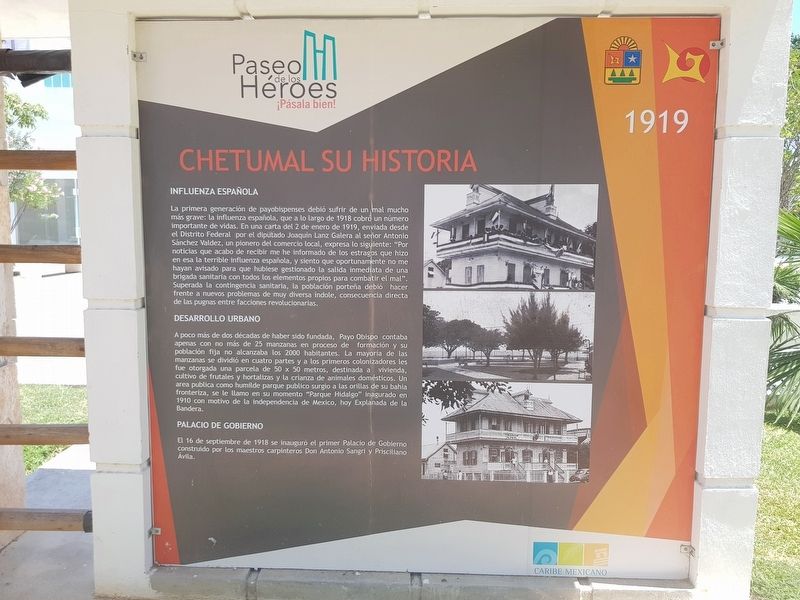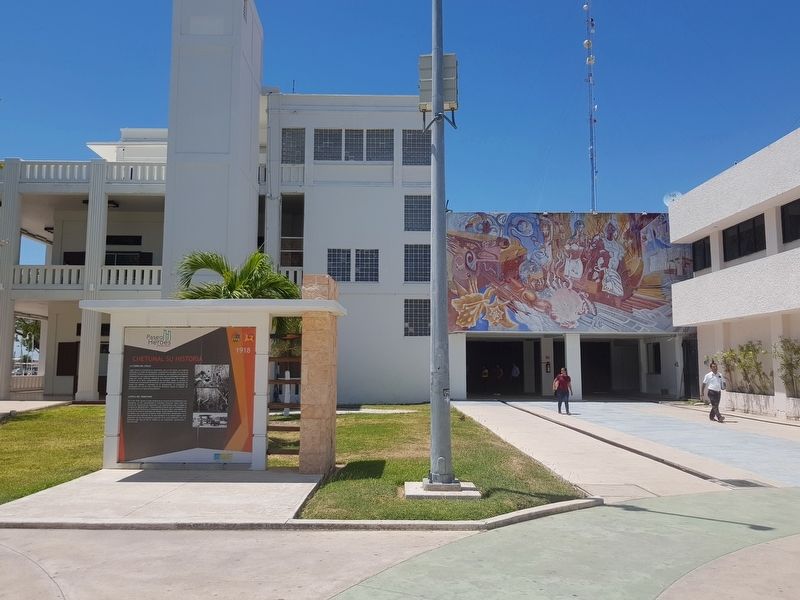Chetumal in Othón P. Blanco, Quintana Roo, Mexico — The Yucatan Peninsula (The Southeast)
The History of Chetumal 1918-1919
Paseo de los Héroes
Inscription.
La Tierra del Chicle
Lugar donde la naturaleza es exuberante, que en sus selvas con maderas preciosas y el árbol de chicozapote, convirtiendo a la región en uno de los emporios chicleros más importantes de Mexico. Los Chicleros eran hombres trabajadores, con largas jornadas en la selva, que se prolongaban en algunos casos por varias semanas, expuestos a las inclemencias del tiempo, al embrujo de la selva, peligrosidad de los animales, donde se cortaba la corteza para la extracción de la resina, para ser recolectada y cocida por las tardes los sábados y domingos en el campamento, la temporada se prolongaba del mes de Julio a finales de diciembre, donde la "bajada" de los chicleros era un gran acontecimiento.
Capital del Territorio
En el año 1918, donde en años anteriores la mayoría de los habitantes eran trabajadores, se fue consolidando la actividad comercial, sobre todo con decreto de "exención de impuestos a las importaciones que se hagan al territorio de Quintana Roo", "para aquellos artículos que se introduzcan en las aduanas del Territorio y se consuman en Quintana Roo", esto debido a la lejanía de los centros nacionales de abasto, lo que también creo un vínculo con Belice, por lo que las primeras casas comerciales establecidas en la capital eran una extensión de las que operaban en la colonia inglesa. Esto determinó uno de los principales aspectos de la novel población y de sus habitantes que hoy en día se refleja en sus costumbres, gastronomía y forma de vida.
Chetumal Su Historia 1919
Influenza Española
La primera generación de payobispenses debió sufrir de un mal mucho más grave: la influenza española, que a lo largo de 1918 cobró un número importante de vidas. En una carta del 2 de enero de 1919, enviada desde el Distrito Federal por el diputado Joaquín Lanz Galera al señor Antonio Sánchez Valdez, un pionero del comercio local, expresa lo siguiente: "Por noticias que acabo de recibir me he informado de los estragos que hizo en esa la terrible influenza española, y siento que oportunamente no me hayan avisado para que hubiese gestionado la salida inmediata de una brigada sanitaria con todos los elementos propios para combatir el mal". Superada la contingencia sanitaria, la población porteña debió hacer frente a nuevos problemas de muy diversa índole, consecuencia directa de las pugnas entre facciones revolucionarias.
Desarrollo Urbano
A poco más de dos décadas de haber sido fundada, Payo Obispo contaba apenas
con no más de 25 manzanas en proceso de formación y su población fija no alcanzaba los 2000 habitantes. La mayoría de las manzanas se dividió en cuatro partes y a los primeros colonizadores les fue otorgada una parcela de 50 x 50 metros, destinada a vivienda, cultivo de frutales y hortalizas y la crianza de animales domésticos. Un área publica como humilde parque público surgió a las orillas de su bahía fronteriza, se le llamó en su momento "Parque Hidalgo" inaugurado en 1910 con motivo de la independencia de Mexico, hoy Explanada de la Bandera.
Palacio de Gobierno
El 16 de septiembre de 1918 se inauguró el primer Palacio de Gobierno construido por los maestros carpinteros Don Antonio Sangri y Prisciliano Ávila.
Chetumal and Its History - 1918
The Land of Chewing Gum
In this place nature is exuberant, with its jungles with precious woods and the chicozapote or chewing gum tree, turning the region into one of the most important chewing gum producing areas in Mexico. The chicleros were working men, spending long days in the jungle, or in some cases up to several weeks, exposed to inclement weather, to the enchantment of the jungle and the dangerousness of the animals, cutting the chicle bark for the extraction of the resin, to be collected and cooked in the evenings on Saturdays and Sundays in their
camps. The season lasted from the month of July to the end of December, when the arrival of the chicleros from the forests and jungles was a great event.
Capital of the Territory
In the 1918, when in previous years most of the inhabitants were manual laborers, commercial activity became more important in Chetumal, especially with the passing of a decree for the "exemption from taxes on imports to the territory of Quintana Roo " and "for those articles that are introduced in the customs of the Territory and consumed in Quintana Roo." This was due to the great distances from the national supply centers. This also created a bond with Belize, so the first commercial houses established in the capital were an extension of those that operated in the English colony. This determined one of the main aspects of the new population and its inhabitants and is still reflected in their customs, gastronomy and way of life.
Chetumal and Its History - 1919
Spanish Influenza
The first generation of inhabitants in what was then called Payo Obispo suffered from a serious malady: Spanish influenza, which throughout 1918 claimed a significant number of lives. In a letter dated January 2, 1919, sent from the Federal District by the deputy Joaquín Lanz Galera to Mr. Antonio Sánchez Váldez, a pioneer in local commerce, he expressed the following: "From the news that I have just received, I have heard reported the ravages done by that terrible Spanish flu, and I feel that in due time I have not been warned to have managed the immediate sending of a health brigade with all the proper elements to combat this evil." Once the health emergency had been overcome, the port’s population had to face new problems of a very different nature - a direct consequence of the struggles between revolutionary factions.
Urban Development
A little more than two decades after being founded, Payo Obispo had only around 45 acres under development and its population was only around 2000 inhabitants. Most of the town lots were divided into four parts and the first settlers were granted a plot of 50 x 50 meters, intended for housing, fruit and vegetable cultivation and the raising of domestic animals. A public area was set aside for a humble public park on the shores of its bordering bay. It was called "Parque Hidalgo" at the time and inaugurated in 1910 on the occasion of the anniversary of the independence of Mexico. Today it is known as the Explanada de la Bandera (The Plaza of the Flag).
Government Palace
On September 16, 1918, the first Government Palace built by master carpenters Antonio Sangri and Prisciliano Ávila was inaugurated.
Topics. This historical marker is listed in these topic lists: Industry & Commerce • Parks & Recreational Areas. A significant historical date for this entry is January 2, 1919.
Location. 18° 29.632′ N, 88° 17.84′ W. Marker is in Chetumal, Quintana Roo, in Othón P. Blanco. Marker is on Avenida de los Héroes just north of 22 de Enero, on the left when traveling north. Touch for map. Marker is in this post office area: Chetumal QR 77000, Mexico. Touch for directions.
Other nearby markers. At least 8 other markers are within walking distance of this marker. Elio Carmichael (a few steps from this marker); Government Palace (within shouting distance of this marker); The Clock Tower (within shouting distance of this marker); Manuel Ávila Camacho Theater (within shouting distance of this marker); Musical Band (within shouting distance of this marker); The History of Chetumal 1898-1905 (within shouting distance of this marker); a different marker also named The Clock Tower (within shouting distance of this marker); Andrés Quintana Roo (about 90 meters away, measured in a direct line). Touch for a list and map of all markers in Chetumal.
Credits. This page was last revised on May 15, 2019. It was originally submitted on May 15, 2019, by J. Makali Bruton of Accra, Ghana. This page has been viewed 120 times since then and 4 times this year. Photos: 1, 2, 3. submitted on May 15, 2019, by J. Makali Bruton of Accra, Ghana.


